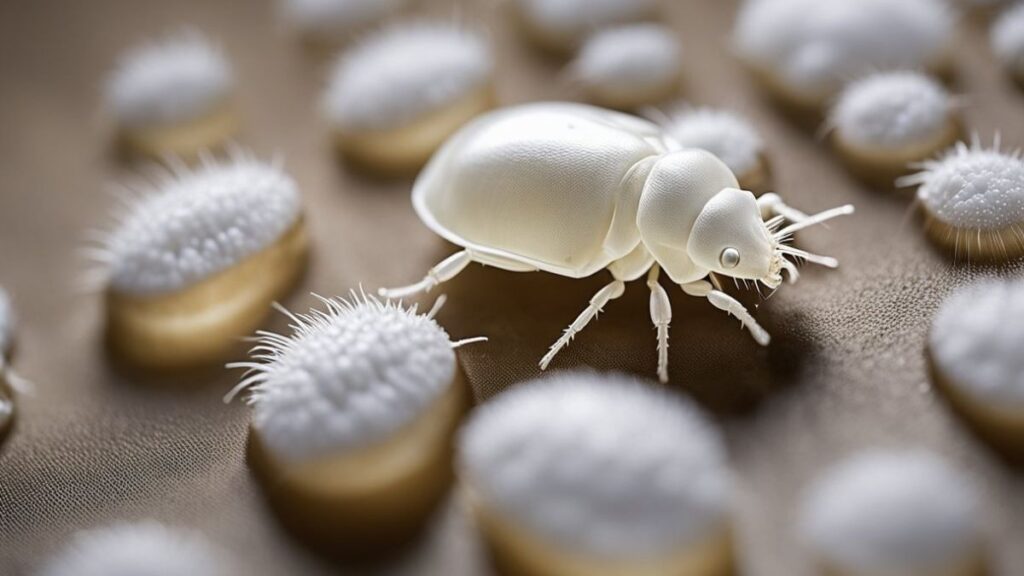How to Get Rid of White Mites in the Kitchen: Top Tips
White mites in the kitchen can be a frustrating and unsightly problem for homeowners. These tiny pests can quickly multiply and infest your food storage areas, making it challenging to keep your kitchen clean and hygienic. Fortunately, there are several methods you can use to get rid of white mites and prevent them from coming back.
- Recognizing White Mites in the Kitchen
- Understanding the Types of Mites
- Identifying 4 Common Causes of Mite Infestation
- The Impact of White Mites
- Initial Steps to Get Rid of White Mites
- Natural Remedies for White Mite Infestation
- Preventing Future Infestations
- When to Seek Professional Help
- Frequently Asked Questions
- How can I eliminate tiny white bugs in my kitchen?
- What are some effective ways to get rid of flour mites?
- Are white mites harmful to humans, and should I be concerned?
- What do flour bugs look like, and how can I identify them?
- Where do flour mites come from, and how can I prevent them?
- How do I kill white mites and keep them from returning to my kitchen?
One of the most effective ways to eliminate white mites is to clean your kitchen thoroughly. This means wiping down all surfaces, including countertops, shelves, and cabinets, with a solution of hot water and vinegar. It would be best if you also vacuumed any cracks or crevices where mites may be hiding, such as around baseboards and inside drawers.
Another option is to use natural insecticides, such as diatomaceous earth or neem oil. These products are safe for humans and pets but deadly for mites. Sprinkle diatomaceous earth or spray a solution of a different natural insecticide in areas where mites are present and wait for them to die off.
Apply carefully away from food and wear gloves and a mask when applying these products. Keep reading for additional info about mites, as well as tips and ways to get rid of them fast.
Recognizing White Mites in the Kitchen
White mites are tiny, white-colored bugs that can be found in the kitchen. They are often hard to spot with the naked eye but can be seen under a magnifying glass. These mites can be mistaken for specks of dust or other small bugs, but they have a distinct shape and movement.
One way to recognize white mites in the kitchen is by their size. They are usually smaller than a grain of rice and can be as small as a speck of dust. They also tend to move quickly and erratically, which can make them stand out from other small bugs.
Another way to recognize white mites is by their color. They are usually pure white in color, although some may have a slight yellow or brown tint. This can make them difficult to see against a white background, such as a white counter or appliance.
If you suspect that you have white mites in your kitchen, it is important to take action quickly. These pests can reproduce rapidly and can quickly infest your entire kitchen. Look for signs of infestation, such as clusters of mites or small white eggs, and take steps to eliminate them as soon as possible.
In a later section, we will discuss some effective methods for getting rid of white mites in the kitchen.
Understanding the Types of Mites
Mites are tiny arthropods that belong to the family of spiders and ticks. They can be found in various environments, including homes, gardens, and farms. Several types of mites can infest a kitchen, and understanding their differences can help you identify the source of the problem and take appropriate measures to get rid of them.
Grain Mites
Grain mites are common household pests that infest stored food products, such as flour, cereal, and pet food. They are tiny and white and can be seen crawling on the surface of the food. Female grain mites can lay up to 800 eggs, which can hatch in as little as three days. A flour mite infestation can cause the food to have a musty or sour smell and taste. These are most likely the mites you’re seeing in your kitchen!
Mold Mites
Mold mites are attracted to damp environments and can be found in areas with high humidity, such as kitchens and bathrooms. They feed on mold and fungi and can be seen crawling on walls, ceilings, and other surfaces. Mold mites are tiny and white and can be difficult to see with the naked eye.
Wood Mites
Wood mites are common in damp wood and can be found in wooden furniture and kitchen cabinets. They are tiny and white and can be seen crawling on the surface of the wood. Wood mites can cause damage to wooden structures and furniture if left untreated.
Dust and Spider Mites
Dust mites and spider mites are common household pests that can be found in various environments, including kitchens. Dust mites feed on dead skin cells and can cause allergies and asthma in some people. Spider mites are plant pests that feed on leaves and can cause damage to indoor plants.
In conclusion, understanding the different types of mites can help you identify the source of the problem and take appropriate measures to eliminate them. It is important to keep your kitchen clean and dry to prevent mite infestations.
Identifying 4 Common Causes of Mite Infestation
White mites in the kitchen can be a nuisance and can contaminate food items. To get rid of them, it is important to identify the causes of infestation. Here are some common causes of white mite infestations in kitchens:
1.) Food Sources
White mites are attracted to food sources such as dry goods, pet food, and pantry items. They can also infest stored food items and grain products. It is important to inspect food storage areas regularly and dispose of any infested items.
2.) Humid Conditions
White mites thrive in humid environments. High humidity levels in the kitchen can create an ideal breeding ground for these pests. It is important to maintain proper ventilation and keep the kitchen dry to prevent infestations. With that in mind, be sure to turn on the exhaust fan when cooking.
3.) Water Leakage
Leaky pipes and excess moisture can create a damp environment in the kitchen, which can attract white mites. Regularly inspecting and fixing any water leakages can prevent infestations, not to mention costly water damage repairs later.
4.) Food Packages
White mites can also infest food packages. It is important to inspect food packages before storing them in the pantry. Discard any packages that show signs of infestation.
In summary, white mite infestations in the kitchen can be caused by food sources, humid conditions, water leakages, and infested food packages. By identifying the causes of infestation, steps can be taken to prevent and get rid of these pests.
The Impact of White Mites
White mites may seem like a minor inconvenience, but they can have a significant impact on your kitchen and health. These tiny bugs can cause allergic reactions and skin irritation, making being in your kitchen uncomfortable.
Furthermore, many mites thrive in moist environments with rotten wood. That means it would be a good idea to check for possibly hidden areas of moisture around active infestation areas.
Mites can also carry harmful bacteria and viruses. Although it’s quite rare to get sick from mites in this way in the United States, they can be more dangerous in large infestations.
Another issue with white mites is the dust they produce. This mite dust can cause respiratory problems, especially for those with asthma or other respiratory conditions. It is essential to clean up any mite dust as soon as it is detected to prevent it from spreading throughout the kitchen.
In summary, while mites may not pose a serious danger to most people, you should take action right away to eliminate them from your living spaces, including the kitchen.
Initial Steps to Get Rid of White Mites
If you have discovered white mites in your kitchen, it is important to take action right away to prevent them from spreading to other areas of the house. Here are some initial steps you can take to get rid of white mites:
- Identify the source: The first step in getting rid of white mites is to identify where they are coming from. Check your pantry, cabinets, and any other areas where food is stored to see if there are any signs of infestation.
- Use the best way to eliminate them: Once you have identified the source, you can choose the best way to eliminate the mites. There are a variety of pest control options available, including natural predators, insecticides, and traps. There are easy DIY sprays you can make, one of which we’ll include a recipe for below.
- Vacuum cleaner: Start by using a vacuum cleaner with a HEPA filter to remove any visible mites and their eggs from your kitchen counter and other surfaces.
- Warm, soapy water: Next, wipe down all surfaces with warm, soapy water to remove any remaining mites and their eggs.
- Hot water: Wash all dishes, utensils, and food containers in hot water to kill any mites that may be hiding in or on those items.
By following these initial steps, you can significantly reduce the number of white mites in your kitchen. However, it is important to continue to monitor the area and take further action if necessary to prevent a re-infestation.
Natural Remedies for White Mite Infestation
If you’re looking for a natural solution to get rid of white mites in your kitchen, there are a few good ideas to consider. Essential oils and diatomaceous earth are two popular remedies that can help eliminate these pests.
Using Essential Oils
In one study with 14 different essential oils, clove essential oil was shown to be the most effective in killing mites. You can easily make a spray containing 8-12 ounces of water, a few ounces of apple cider vinegar, then about 20 drops of clove essential oil and other essential oils, depending on your fragrance preference.
Natural Mite Killer Spray with Clove and Apple Cider Vinegar
Ingredients:
- 1 cup of water
- 1/4 cup of apple cider vinegar
- 15-25 drops of clove essential oil
- A few drops of other essential oils according to fragrance preference, such as lavender, rose, orange, or others.
Instructions:
- Mix all the ingredients in a spray bottle.
- Shake well to ensure that the ingredients are well mixed.
- Spray the mixture on the affected areas where mites are present.
- Repeat the process daily until the mites are completely eliminated.
Note: Clove essential oil can be potent and cause skin irritation or allergic reactions in some people. It’s best to do a patch test before using the spray on a larger area. If unsure, wear gloves and avoid contact with the skin. Additionally, you could use chamomile essential oil instead or mix the two. Also, be sure to keep the spray away from children and pets.
Peppermint can also be a great option to mix with the above solution to offset the smell of the vinegar. Other effective essential oils referenced in the aforementioned study for killing mites are eucalyptus and chamomile; plus, they smell lovely, too.
Applying Diatomaceous Earth
Diatomaceous earth is a natural powder made from fossilized diatoms, a type of algae. It’s a great option for getting rid of white mites because it’s safe to use around food and pets. Simply sprinkle the powder around the affected areas and let it sit for a few days. The diatomaceous earth will dehydrate the mites and kill them.
Overall, using natural remedies like essential oils and diatomaceous earth can be an effective way to get rid of white mites in your kitchen. Just be sure to repeat applications of either until the infestation is gone. Depending on the sizer and severity of the infestation, the whole process could take 1-2 weeks.
Add clove essential oil to your DIY all-purpose kitchen cleaner to prevent the mites from returning. But, more on prevention in the next section
Preventing Future Infestations
To prevent future infestations of white mites in the kitchen, it is important to take some necessary precautions.
Firstly, ensure that all food items are stored in sealed containers. This will help prevent the mites from gaining access to the food and laying eggs. Keeping the kitchen clean and free of any food debris that may attract the mites is also important.
The next step in preventing future infestations is to identify the source of the mites. If the mites are coming from a specific food item, it is important to remove the item from the kitchen and dispose of it properly. If the mites commonly come from a specific kitchen area, thoroughly cleaning and disinfecting that area is important.
One cleaning isn’t enough. Clean regularly and use natural methods like essential oils a few times a week until and after there’s no longer any evidence of mites.
By following these steps, it is possible to prevent future infestations of white mites in the kitchen.
When to Seek Professional Help
While there are many ways to get rid of white mites in the kitchen, sometimes it’s best to call in the professionals. Here are some situations where it may be necessary to seek professional help:
When the Infestation is Severe
If the infestation is severe, it may be difficult to get rid of the white mites on your own. In such cases, it’s best to call in a pest control expert with the knowledge and tools to handle the situation. They will be able to identify the type of pest, assess the severity of the infestation, and come up with a plan to eliminate the mites.
When You’re Not Sure How to Proceed
If you’re not sure how to proceed or are dealing with a particularly stubborn infestation, it may be best to seek the advice of a professional. They can guide you on how to get rid of the white mites and prevent them from returning.
When You Need Personal Protective Equipment
Some methods of getting rid of white mites may require the use of personal protective equipment (PPE), such as gloves, masks, and goggles. If you’re uncomfortable using PPE or don’t have access to the necessary equipment, it’s best to call in a professional who can handle the situation safely.
When You Want to Prevent Future Infestations
If you want to prevent future infestations, a professional can help you identify the source of the problem and devise a plan to prevent it from happening again. They can also provide you with tips on how to keep your kitchen clean and free of pests in general.
In summary, if the infestation is severe, you’re not sure how to proceed, you need personal protective equipment, or you want more guidance on preventing future infestations, it’s best to seek professional help. A pest control expert can provide you with the knowledge and tools to eliminate white mites in your kitchen.
Frequently Asked Questions
How can I eliminate tiny white bugs in my kitchen?
There are several ways to eliminate white mites in the kitchen. One method is to clean all surfaces and utensils thoroughly with hot, soapy water. You can also use a vacuum cleaner to remove any mites that may be hiding in corners or cracks. Another option is to create a DIY spray containing essential oils, live clove, or chamomile essential oil.
What are some effective ways to get rid of flour mites?
Flour mites can be eliminated by freezing the flour for a few days or heating it in the oven at a high temperature (mites die at 104 degrees or higher. You can also store flour in airtight containers to prevent mites from infesting it. Additionally, cleaning the kitchen regularly and disposing of any infested food can help get rid of flour mites.
Are white mites harmful to humans, and should I be concerned?
White mites are generally not harmful to humans, but they can cause allergies in some people. If you have a history of allergies, it is best to take precautions and get rid of the mites as soon as possible, especially for more severe infestations.
What do flour bugs look like, and how can I identify them?
Flour mites are tiny white bugs that are difficult to see with the naked eye. They are about 0.013 to 0.017 inches in size and have a soft body. You can identify them by looking for small white specks in your flour or other dry food products.
Where do flour mites come from, and how can I prevent them?
Flour mites come from contaminated food products or infested storage areas. To prevent them, it is important to store dry food products in airtight containers and clean the storage area regularly. You should also inspect food products before purchasing them to ensure they are not infested.
How do I kill white mites and keep them from returning to my kitchen?
To kill white mites, you can use insecticides or natural remedies such as diatomaceous earth or essential oils. To prevent them from returning, it is important to keep the kitchen clean and free of food debris. You should also store food products in airtight containers and inspect them regularly for signs of infestation.


